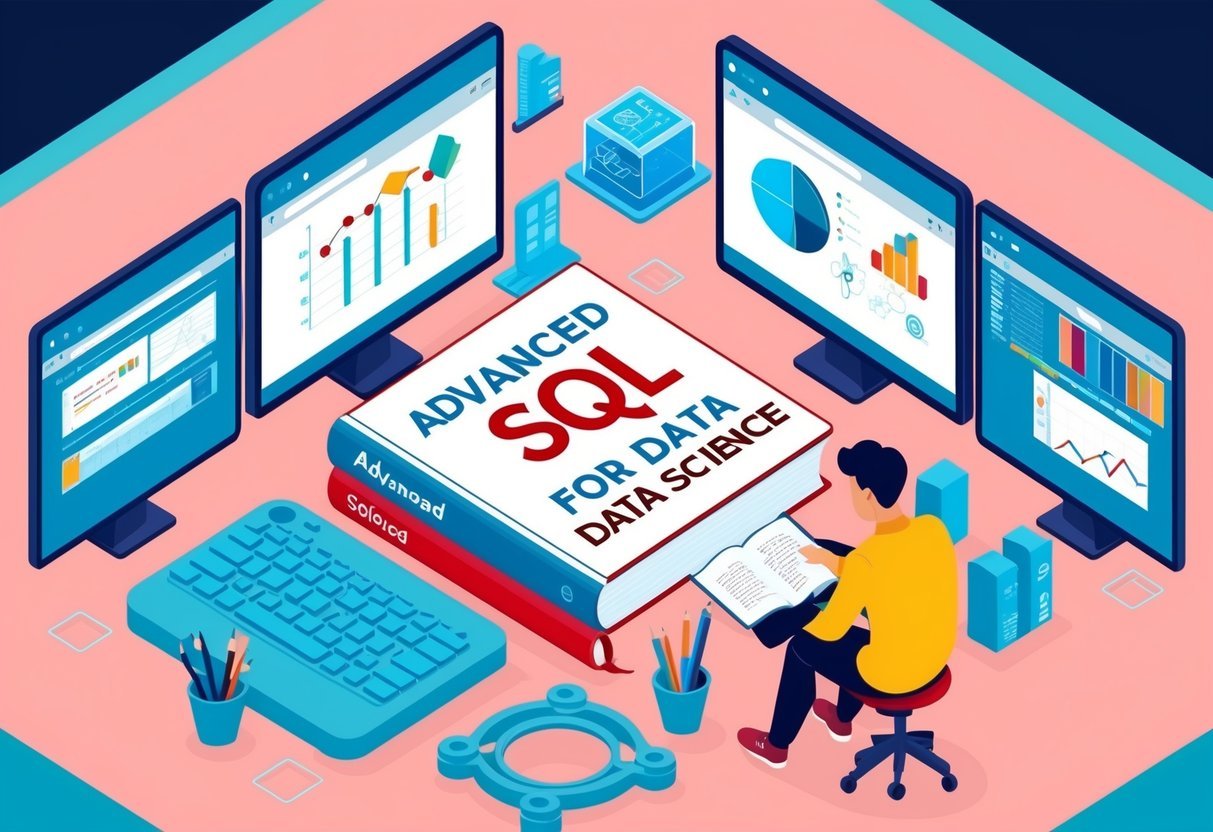Understanding Advanced SQL Concepts
Advanced SQL skills play a pivotal role in data science, enabling data professionals to handle complex data analysis tasks efficiently. These skills go beyond basic querying, offering deeper functionalities that are essential for sophisticated data manipulation.
Importance of SQL in Data Science
SQL remains a powerful tool for data scientists. It is crucial for managing and querying large datasets, which are common in data science projects. The ability to write efficient and optimized queries helps in retrieving necessary information quickly. This is essential when working with vast amounts of data.
Data scientists often use SQL to extract data for analysis. Advanced SQL techniques, like window functions and joins, allow them to perform complex calculations that are vital for creating data models. These skills are indispensable for anyone aiming to excel in data science. Further exploration into these techniques can be found in learning resources, such as those on LinkedIn.
Differentiating Between Basic and Advanced SQL
Basic SQL includes operations like selecting, inserting, and updating data in tables. These skills provide a foundation for managing data but are not enough for complex analysis. Advanced SQL, on the other hand, involves concepts like aggregate functions and subqueries, which are integral to deeper data analysis.
Advanced SQL allows for more efficient data handling. Techniques such as pivoting, window functions, and complex joins enable data scientists to manipulate data in sophisticated ways. Mastering these advanced concepts enhances the ability to uncover insights from data, which is discussed in resources like those found on Airbyte.
Deep Dive into SQL Functions
SQL functions play a crucial role in data manipulation and analysis. They help perform operations on data, simplifying complex calculations and logic in queries. Mastering these functions enhances SQL skills, making data tasks more efficient and versatile.
Built-In SQL Functions
SQL offers a variety of built-in functions that simplify data processing tasks. These include aggregate functions like SUM and COUNT which are used to perform calculations on multiple rows, resulting in a single value.
String functions such as CONCAT and SUBSTRING allow manipulation of text strings, aiding in tasks like data cleaning and formatting.
Date functions, including NOW and DATEDIFF, handle and manipulate date values, essential for time-based analysis.
Mathematical functions like ROUND and POWER perform various calculations, from simple arithmetic to complex equations.
Utililizing these built-in functions can significantly optimize data retrieval and manipulation processes, making query operations smoother and more robust.
Creating User-Defined Functions
User-Defined Functions (UDFs) are essential for scenarios where built-in functions fall short. They allow users to create custom operations tailored to specific needs.
UDFs can be categorized into Scalar UDFs, which return a single value, or Table-Valued UDFs, which return a table.
Creating a UDF involves defining the function using the CREATE FUNCTION statement, specifying input parameters and the desired output. These functions enhance SQL skills by providing flexibility and reusability in queries. UDFs can help simplify complex computations or business logic, making them a powerful tool for data scientists seeking advanced data processing capabilities.
Mastering Joins and Subqueries
Mastering joins and subqueries can significantly enhance the ability to manipulate and analyze complex data sets. Understanding their uses and differences allows SQL users to perform more sophisticated queries and extract valuable insights from data.
Types of Joins
In SQL, joins are used to combine rows from two or more tables based on a related column. The most common types are Inner Join, Left Join, Right Join, and Full Outer Join.
- Inner Join retrieves records that have matching values in both tables.
- Left Join returns all records from the left table, and the matched records from the right table, with
NULLfor no matches. - Right Join does the opposite, retrieving all records from the right table.
- Full Outer Join combines both Left and Right Join, returning all records when there is a match in either table.
Using the correct type of join helps in efficiently fetching data from multiple tables, making SQL queries more robust.
Writing Subqueries
Subqueries are nested queries within a main query. They allow users to perform operations on data that need multiple steps.
- Subqueries can be placed in SELECT, FROM, or WHERE clauses.
- They are useful for performing calculations or comparisons when working with large data sets.
- For example, filtering results based on aggregated data such as total sales across departments can be efficiently handled using subqueries.
Subqueries can simplify complex queries by breaking down tasks into smaller, manageable operations. They improve readability and maintainability of SQL code when used properly.
Subqueries vs. Joins
Deciding between subqueries and joins depends on the problem at hand. Joins are generally preferred when needing data from multiple tables simultaneously.
- Joins can be more efficient and are suitable for parallel combination of data sets.
- Subqueries are ideal for sequential operations where computation from one query affects another.
For instance, using a join is faster when fetching related records from connected tables, whereas subqueries are better when performing aggregate operations or filtering records based on computations. Understanding when to use each can lead to more efficient and readable SQL queries.
Optimizing SQL Queries for Performance
Optimizing SQL queries involves various techniques to make data retrieval efficient and effective. Mastering the Select statement, using Limit and Order By wisely, and implementing indexing strategies significantly enhance query performance, especially when working with large data sets.
Understanding the Select Statement
The Select statement is a fundamental part of SQL queries. It retrieves specific data from a database. Optimizing this part of a query can greatly affect performance.
Using the Select statement efficiently involves specifying only required columns. Avoid using “SELECT *” as it pulls all fields, potentially slowing down the query.
Filtering conditions with the WHERE clause can improve speed by narrowing the dataset before other operations. Additionally, using aggregate functions like SUM or AVG reduces data processing by summarizing large volumes of data.
Effective Use of Limit and Order By
The Limit keyword controls the amount of data retrieved. This is especially useful when users only need a small subset of results, increasing response time and reducing processing load.
Coupled with Order By, Limit ensures the most relevant records are fetched immediately. It helps prioritize the dataset by ordering it according to specified columns.
Proper indexing aligns with the Order By clause, enhancing speed and function. Ensuring the right indexes match the Order By can prevent unnecessary sorting operations, leading to faster retrieval on large datasets.
Indexing Strategies for Large Data Sets
Indexing is a primary method for boosting query performance. Proper indexes can reduce data retrieval times by allowing the database to quickly locate the needed rows.
While indexes speed up searches, it’s important to use them judiciously; too many indexes can slow down the INSERT, UPDATE, and DELETE operations due to maintenance overhead.
In large data sets, multi-column indexes can be particularly effective when queries involve several conditions. Understanding the database’s query execution plan can identify whether indexes are being used effectively. This helps refine and enhance indexing strategies, ensuring optimal performance for complex data operations.
Grouping and Aggregating Data
Grouping and aggregating data are essential skills in SQL for analyzing large data sets. These techniques help consolidate and summarize data efficiently. Key concepts include using the GROUP BY clause and applying aggregate functions to transform and interpret data effectively.
Utilizing Group By Clause
The GROUP BY clause is vital for organizing data into distinct groups based on one or more columns. When a user needs to analyze data sets to see patterns or trends, GROUP BY is crucial.
For instance, if a company wants to know total sales by product, grouping the data by the product name can help achieve this.
It creates groups of entries in a table that share the same values in specified columns. After applying GROUP BY, various aggregate functions process these groups to provide meaningful insights. This approach is invaluable in contexts where details like sales, counts, or averages of grouped items are necessary for business decisions.
Exploring Aggregate Functions
Aggregate functions are essential for summarizing data in SQL queries. These functions perform calculations on a set of values and return a single value.
Common aggregate functions include COUNT, SUM, AVG, MIN, and MAX. They help in getting essential statistics about a data set.
For example, to understand sales performance, the SUM function can be used to calculate total sales, while AVG can show average sales figures.
When combined with GROUP BY, these functions allow users to perform detailed analysis on grouped data, offering insights into trends and performance metrics. This helps in making informed decisions based on comprehensive data analysis.
Working with Advanced Data Structures

Advanced SQL involves utilizing complex structures like views and data models to enhance data analysis and management. Mastering these enables more efficient querying and data organization in a relational database.
Designing and Using Views
Views are virtual tables in a relational database that provide a way to present data without altering actual tables. They simplify query management by allowing users to save frequently used queries as views. This leads to cleaner code and easier maintenance.
Using views improves security, as sensitive data can be restricted by limiting access to specific data columns or rows. Additionally, they enable consistent querying across applications by abstracting complex SQL expressions.
To create a view, the CREATE VIEW statement is used, defining its structure based on a SQL query. Efficient use of views can significantly simplify data retrieval processes and promote consistency in data handling.
Exploring Data Models
Data models are essential for structuring data systematically within a relational database. They define how data is stored, organized, and accessed, establishing relationships between different data entities.
Effective data modeling involves understanding both the business requirements and the technical aspects of a database system. Logical data models are used to map out business needs, whereas physical data models focus on the technical implementation.
Advanced data modeling techniques, such as normalization and denormalization, ensure data integrity and optimal performance. By using advanced SQL data modeling techniques, data scientists can design databases that are both robust and scalable, tailored to complex processing needs.
Leveraging Window Functions
Window functions are essential SQL skills for data analysis, enabling users to perform complex calculations across data rows. They provide insights without altering the result set size, which is vital in making nuanced data-driven decisions.
Understanding Over Clause
The OVER clause is fundamental to the function of window operations in SQL. It defines the set of rows that the function operates over.
By using this clause, SQL practitioners can partition data into smaller groups, facilitating calculations like running totals, moving averages, and ranking.
These calculations allow analysts to examine data patterns over time or within specific categories.
For instance, one could employ the clause to calculate a moving average of sales within each region. By partitioning by region, the function targets relevant data subsets, leading to insightful market trends.
Thorough use of the OVER clause enhances the accuracy and richness of data analysis, tasking SQL users with understanding how to apply it strategically to extract valuable insights.
Window Functions in Data Analysis
Window functions play a critical role in data analysis, providing tools for tasks like rankings, aggregations, and cumulative sums.
Unlike general aggregate functions, window functions maintain each row in the query result, giving deeper context.
Common functions include ROW_NUMBER() for assigning unique ranks, RANK() and DENSE_RANK() for ranking data with potential ties, and SUM() for calculating cumulative totals.
Each offers unique insights, valuable in fields like finance or marketing.
These functions help analysts understand data trends and relationships by assessing data holistically.
For practical application and deeper understanding of these techniques, resources such as this advanced course in SQL can be beneficial.
Mastery of window functions enhances analytical capabilities, enabling the solving of complex data challenges effectively.
Integrating SQL with Other Tools

Integrating SQL with tools like Python enhances data analysis capabilities. Python brings flexibility and advanced analytics, while SQL efficiently manages and queries data.
SQL and Python Interoperability
SQL and Python are a powerful combination for data science. Python offers libraries like Pandas, which allow seamless data extraction from SQL databases for further analysis.
This interoperability enables data scientists to perform complex data operations by leveraging SQL’s robust querying capabilities alongside Python’s analytical strength.
Using SQL within Python scripts is possible with libraries such as SQLAlchemy and SQLite. These libraries allow for database connection and easy execution of SQL queries directly within Python, enabling a two-way data interaction.
By integrating SQL with Python, data scientists can automate data workflows and enhance the efficiency of data analysis tasks.
This integration is particularly beneficial when dealing with large datasets, as SQL can efficiently filter and aggregate data, which Python can then visualize or further process.
For an example of how SQL integrates with Python, you can explore more about SQL and Python for data analysis.
Data Visualization with SQL
Data visualization is a crucial step in data analysis, providing clear insights into complex datasets. SQL can be used to prepare data for visualization by querying and organizing data effectively.
When linked with data visualization tools or libraries, SQL enhances the capability to present data in a comprehensible manner.
Tools like Tableau, Power BI, and Python libraries such as Matplotlib and Seaborn can utilize SQL queries to pull data directly from databases. This approach enables real-time data visualization, which is essential for spotting trends and patterns quickly.
Incorporating SQL into data visualization processes ensures that the data presented is both accurate and relevant.
By filtering and refining data through SQL queries, visualizations become more targeted and insightful.
For an in-depth look into using SQL for data manipulation in visualization, consider examining techniques found in advanced SQL methods for data visualization.
Data Engineering and Management

Data engineering involves creating efficient ways to handle vast amounts of data. Effective data management ensures that data is accessible, reliable, and secure for analysis.
Database Management Essentials
Database management is crucial for storing and organizing data in a structured manner. Data engineers focus on designing systems that are scalable and maintain data integrity.
They often use relational databases like MySQL and PostgreSQL, which support SQL for querying data.
Efficient database management also involves indexing for quick data retrieval and normalization to reduce redundancy. Understanding ACID (Atomicity, Consistency, Isolation, Durability) properties helps maintain reliable transactions.
Tools such as Oracle and Microsoft SQL Server are popular choices in the industry due to their robust features for managing large datasets.
Data Extraction, Transformation, and Loading (ETL)
ETL processes are essential for moving data from various sources into a unified system. Extraction involves retrieving data from different databases or external sources like APIs.
Transformation ensures that data is cleaned and converted into a usable format. This step is vital for consistency and accuracy in analysis.
Loading is the final step, where prepared data is stored in a data warehouse or analytics platform.
Technologies like Apache Kafka and Apache Spark enhance the ETL process, enabling real-time data processing. These tools allow data engineers to handle big data efficiently, ensuring that insights can be derived quickly and effectively.
Developing Professional SQL Expertise

Mastering SQL is essential for data science and database administration roles. By gaining professional SQL expertise, individuals can significantly enhance their technical skills and career opportunities.
Building a Shareable Certificate and LinkedIn Profile
Professionals often benefit from showcasing their skills through recognized certifications. Platforms like Coursera offer a range of advanced SQL courses where participants can earn a Shareable Certificate. This certificate can validate their expertise to potential employers.
Adding these certificates to a LinkedIn Profile can boost credibility. Displaying certifications on LinkedIn allows data scientists and database administrators to stand out in a competitive job market. It highlights their commitment to continuous learning and skill advancement.
Pursuing Further Education through Online Degrees and Specializations
Advanced SQL skills can be further developed through academic paths like online degrees. Courses from platforms such as Coursera Plus provide comprehensive learning experiences tailored to data science.
These programs often dive into complex topics like database optimization and data manipulation.
Online degrees and career certificates can offer flexible learning that fits around existing work commitments. They provide a structured learning path and often include specializations that cater to specific career goals, whether merging SQL proficiency with data science or focusing on administration skills.
They serve as a substantial addition to professional credentials in the tech industry.
Case Studies in SQL for Data Science

Using SQL for data science allows professionals to gain impactful insights through structured data analysis. These insights drive decision-making in various sectors, aiding data scientists in their quest to uncover patterns and trends.
Real-World Applications of SQL
SQL applications in data science are crucial in industries like finance, healthcare, and retail. Data scientists utilize SQL to handle large datasets efficiently, enabling them to perform analytics and derive statistical insights.
For example, in finance, SQL helps track and predict market trends by analyzing transaction data. In healthcare, patient records are examined to improve treatment outcomes, showcasing the importance of SQL in managing complex data. Retailers use SQL to analyze customer behavior, tailoring marketing strategies to boost sales and customer satisfaction.
A practical benefit of SQL is its ability to aggregate and filter data quickly, empowering analysts to explore vast amounts of information seamlessly. This capability is essential in businesses where data-driven strategies are pivotal for growth and success.
SQL in Global Companies and the Digital Economy
In the digital economy, global companies rely on SQL for their data infrastructure. These organizations face vast datasets daily, requiring efficient data processing and analysis.
SQL provides the framework for handling such data volumes, aiding in decision-making and strategic planning.
Tech giants, for instance, use SQL to refine their user experience through data-driven insights. By analyzing user interactions, companies can enhance platform features and recommend products or services accurately. This data-centric approach not only improves user satisfaction but also drives revenue growth.
Moreover, SQL’s role in the digital economy extends to supporting transaction systems and customer relationship management. This helps businesses maintain competitive edges by understanding market dynamics and consumer trends with precision and ease.
Preparing for the Job Market

SQL skills are crucial for those aiming to enter data science roles. The job market values candidates who can both demonstrate technical knowledge and show practical experience through projects.
Identifying Job-Relevant Skills and Assessments
To succeed in the data science job market, candidates must focus on key SQL skills. These include understanding complex joins, subqueries, and using window functions effectively. It’s also important to know how to handle data types like JSON, XML, and strings.
Candidates should engage in assessments that test these abilities. Many online platforms offer quizzes and challenges tailored for aspiring data professionals.
These assessments help identify strengths and areas for improvement. Organizations often seek proof of skills, making them crucial for job readiness.
Engaging in Hands-on Projects
Hands-on projects are a critical component of preparing for a data science career. They provide a practical way to apply SQL skills in real scenarios. Projects might involve database design, data cleaning, or analysis tasks.
Participating in open-source projects or contributing to community-driven databases can be beneficial.
Creating a portfolio with these projects showcases talent to potential employers. Engaging in real-time organizational challenges can simulate workplace environments, preparing candidates for actual job demands. These experiences prove invaluable in standing out in the competitive job market.
Frequently Asked Questions

Advanced SQL skills are crucial for data scientists to efficiently manage and analyze complex data sets. Earning certifications, knowing best practices, and mastering these skills can greatly enhance a data professional’s ability to optimize data workflows.
What are the essential advanced SQL concepts a data scientist should master?
Data scientists should focus on mastering concepts like indexing, window functions, and complex joins. Skills in handling large datasets through subqueries and optimizing query performance are important. Understanding advanced ranking functions can also be valuable in tasks like sorting data efficiently.
How can one obtain a certification in advanced SQL specifically tailored for data analytics?
To obtain a certification in advanced SQL for data analytics, professionals can enroll in programs offered by recognized institutions.
These certifications often focus on advanced database management and analytical skills. Popular platforms like Coursera or edX might offer relevant courses, aligning with industry standards and covering necessary skills.
What are the best practices for using SQL in complex data analysis scenarios?
Best practices include writing efficient queries to minimize computation time and using indexing to speed up data retrieval.
Structuring databases with normalization can prevent redundant data, ensuring accuracy. Additionally, using batch processing can optimize resource use during analysis.
Are there any recommended online courses for learning advanced SQL skills for free?
There are various online platforms offering free courses in advanced SQL, such as Khan Academy and Coursera.
These courses provide comprehensive materials ranging from fundamental topics to advanced concepts, enabling learners to build a robust foundation in SQL necessary for data science.
Can mastering advanced SQL significantly improve data manipulation and querying efficiency for data engineers?
Mastering advanced SQL can greatly enhance efficiency in querying and data manipulation tasks. Data engineers can retrieve and transform data more quickly and accurately.
This leads to improvements in how data pipelines are managed, especially when dealing with large-scale datasets.
What differences exist between basic SQL skills and advanced SQL skills in the context of data science?
Basic SQL skills typically involve simple queries, data retrieval, and basic table manipulations.
Advanced SQL skills include complex query writing, performance tuning, and advanced data transformations like window functions and recursive queries.
These advanced skills enable deeper data analysis and more efficient handling of complex datasets.
